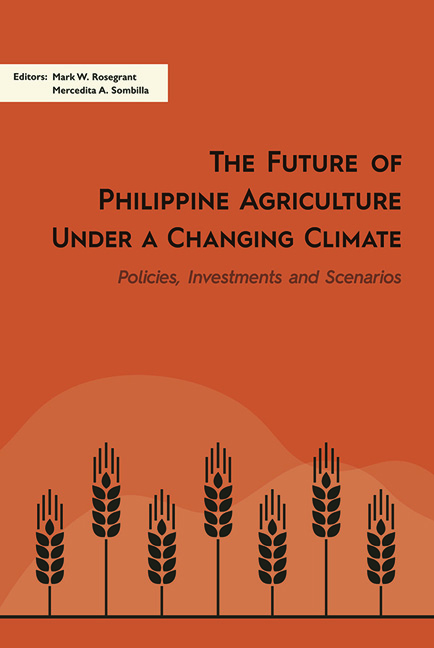Book contents
- Frontmatter
- Contents
- List of Tables
- List of Figures
- List of Appendices
- Preface
- Acknowledgements
- List of Contributors
- PART I Setting up the Scenarios: Current Status and Potential Impacts of Climate Change to Philippine Agriculture
- PART II Climate Change Adaptation Strategies and Sustainability of Philippine Agriculture
- 5 The Sustainability of Agricultural Growth
- 6 The Gendered Impacts of Climate Change
- 7 Adaptation and Mitigation Strategies
- 8 Risk Management and Coping Strategies
- PART III Investments and Supporting Policies to Alleviate Climate Change Impacts to Philippine Agriculture
- PART IV Conclusion
- Index
5 - The Sustainability of Agricultural Growth
from PART II - Climate Change Adaptation Strategies and Sustainability of Philippine Agriculture
Published online by Cambridge University Press: 29 May 2019
- Frontmatter
- Contents
- List of Tables
- List of Figures
- List of Appendices
- Preface
- Acknowledgements
- List of Contributors
- PART I Setting up the Scenarios: Current Status and Potential Impacts of Climate Change to Philippine Agriculture
- PART II Climate Change Adaptation Strategies and Sustainability of Philippine Agriculture
- 5 The Sustainability of Agricultural Growth
- 6 The Gendered Impacts of Climate Change
- 7 Adaptation and Mitigation Strategies
- 8 Risk Management and Coping Strategies
- PART III Investments and Supporting Policies to Alleviate Climate Change Impacts to Philippine Agriculture
- PART IV Conclusion
- Index
Summary
Globally, agricultural development policy and related initiatives have shifted and evolved over time, in part prompted by emerging issues and the prevailing milieu. Tracing the general eras of these shifts, Hazell (1999) notes that during the early 1950s and 1960s, agricultural researchers were preoccupied with the quest to increase agricultural growth and economic development by improving and enriching “the five eyes” of agricultural development: (1) innovation, by strengthening agricultural research and extension; (2) infrastructure; (3) input-use efficiency; (4) institutions, by liberalizing markets and trade; and (5) incentives. Experiences during these years prompted policymakers and development experts to expand the agricultural development paradigm in the 1980s and 1990s to include alleviating poverty and ensuring food security. Hazell (1999) calls these aspects the “equity modifiers” of earlier growth-centred agricultural development policy. By the 1990s policymakers began to recognize that agriculture should contribute to economic growth, development, and poverty reduction without harming the environment — thus, the concept of environmentally sustainable agricultural growth was born.
Agricultural development in the Philippines has closely followed these trends. In fact, the country's Agriculture and Fisheries Modernization Act of 1997 (Government of the Philippines 1997, p. 2) declared that the State should “promote development that is compatible with the preservation of the ecosystem in areas where agriculture and fisheries activities are carried out [and] … exert care and judicious use of the country's natural resources in order to attain long-term sustainability.” Despite these intentions, nationallevel environmental accounting has generally slowed since the early 2000s, when several donor-funded projects were completed (Bennagen 2007). Both the funding and human resource capacity to collect relevant data on the environmental impacts of national and sectoral economic activity has dwindled since the turn of the millennium. Attempts to explore the impacts of micro-level agricultural activity in 2000 were confined to rice cultivation in the uplands (NSCB–UNDP 2000). Furthermore, in addition to scope limitations, studies have failed to account for the effects of environmental degradation on agriculture, especially in terms of growth and sustainability.
The concept of sustainable development is often rooted in the Bruntland Commission's definition, which focuses on meeting present needs without compromising the needs of future generations (WCED 1987).
- Type
- Chapter
- Information
- The Future of Philippine Agriculture under a Changing ClimatePolicies, Investments and Scenarios, pp. 211 - 259Publisher: ISEAS–Yusof Ishak InstitutePrint publication year: 2018



